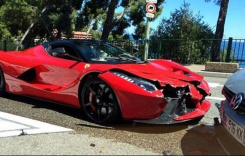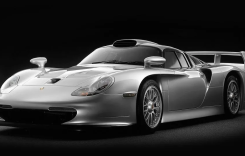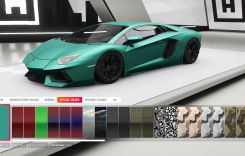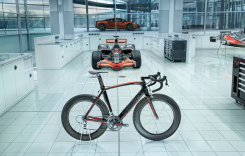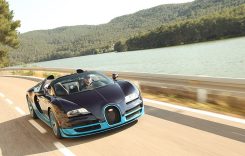Honda’s 2014 CRF250R ($7420 plus $310 destination charge) follows in the tire tracks of its larger displacement CRF450R sibling with an important chassis update for more predictable handling on the track and trail. Highlights include an all-new frame, swingarm and up-spec engine configuration for added roost-throwing muscle. For a more in-depth technical analysis check out the 2014 Honda CRF250R First Look, as this article zeroes in on riding impressions and what this quarter-liter CRF is like to moto.

Hop on the CRF and it is clear that the engineers spent a lot of time getting the 250’s weight distribution just right. Even though the ’14 bike weighs four pounds more than the machine it replaces, you’d be hard pressed to notice the difference whether lifting it off the stand or leaning it over through an inside rut.
The 2010-2013 generation CRF was renowned for its sharp steering precision and Big Red’s latest 250 continues to shine in that area. However, it’s far less hyper and more relaxed-feeling than before.
(Top) The CRF250R’s engine features a new cylinder head design with more compression and unique dual-stage fuel injection programming for improved engine response. (Center) The shock is positioned lower in the chassis for added stability and works through a new linkage with a flatter link for better response in motion. (Bottom) After a three-year hiatus, the Honda CRF250R returns to a twin muffler design.
“The chassis felt very balanced and seemed to flex well,” said pro-level test rider Chris See. “You could come into inside rights and put the weight on the front tire and it would go that direction. It was very good.”
Contrary to the latest and greatest air fork technology used on the CRF450R, the 250 still employs a conventional dual coil spring fork. Although it’s relatively old technology, as some say, ‘if it ain’t broke, don’t fix it’ – an accurate synopsis of our feelings of Showa’s tried-and-true design.
Despite not being the newest piece of suspension equipment, we love this fork’s organic feel and straightforward adjustment with it providing adequate pitch control during braking and corner entry over bumps. Our only criticism is that it is a little on the soft side – a typical complaint by faster riders or those who aren’t lightweights. Fortunately, the fix is as simple as swap to a heavier pair of springs.
“I think the conventional fork is the way to go,” said See. “I don’t think that either one of the other options [air fork or single function/single coil spring fork] are really proven. I had no real issues with the suspension today. I think it could be definitely a little stiffer all around and for anyone over probably 150 pounds.”
We were also pleased with the function of the shock, which is now positioned lower in the frame. This helps boost stability at speed over bumps and acceleration whoops.
The CRF250R now shares identical and interchangeable body panels and Renthal handlebar (971 bend) as the CRF450R – a big plus for racers who compete in both the 250 and 450 four-stroke classes. Not only do the new plastics look sleek, they are functional providing unencumbered body movements entering and exiting turns as well as through whoops and other obstacles. Another plus is that the capacity of the fuel tank has been increased by almost two-thirds of a quart, so you can ride longer between re-fills.
Motor-wise the CRF250R’s engine continues to have a smooth and well-rounded powerband. Although it didn’t blow us away in any one area, we appreciated the added snappiness of the engine courtesy of Honda’s dual-stage fuel injector map that pre-charges the combustion chamber with an extra squirt of fuel elevating both response and power production.
“The motor was very similar to the 2013,” sums up See. “It did feel like it had slightly more bottom end power but it was very minimal and felt very similar to last year’s bike with a lot of top-end and not very much middle [mid-range]. I feel that the bottom end is decent but it could use one tooth bigger on the rear sprocket to bring the transmission closer together.”
(Top) The most noticeable difference to the Honda CRF250R’s engine is the dual-stage fuel injection mapping which pre-charges the combustion chamber with fuel for added snappiness and engine response at all rpms. (Center) The body panels, 1.66-gallon fuel tank and Renthal 971 bend handlebar are identical to the CRF450R. (Below) The CRF250R has never been lacking in terms of cornering ability. But the new chassis adds an element of refinement and chassis stability making it easier to ride than ever before.
In spite of See’s final drive gearing complaint (13/49) the rest of the Honda’s drivetrain performed flawlessly. The clutch offers well-weighted lever pull and is offers excellent response even with a light two finger tug of it. The transmission also shifted securing in each of its five gears making for a bike that is easy to ride.
While the braking components and the specification of the Dunlop Geomax tires are unchanged both worked well. The brakes offered plenty of stopping power with a fair amount of lever feel and the knobs served up excellent grip on a moist track but were a little squeamish in the morning when the track was dry (the track’s water pump stopped working), but that’s to be expected.
Considering the championship-winning success of the 2013 CRF250R it would have been easy for Honda to leave well enough alone. Instead by incorporating successful and well-received chassis changes from the CRF450R it has produced a 250-class racer that is even more adept at putting in fast laps with ease.

